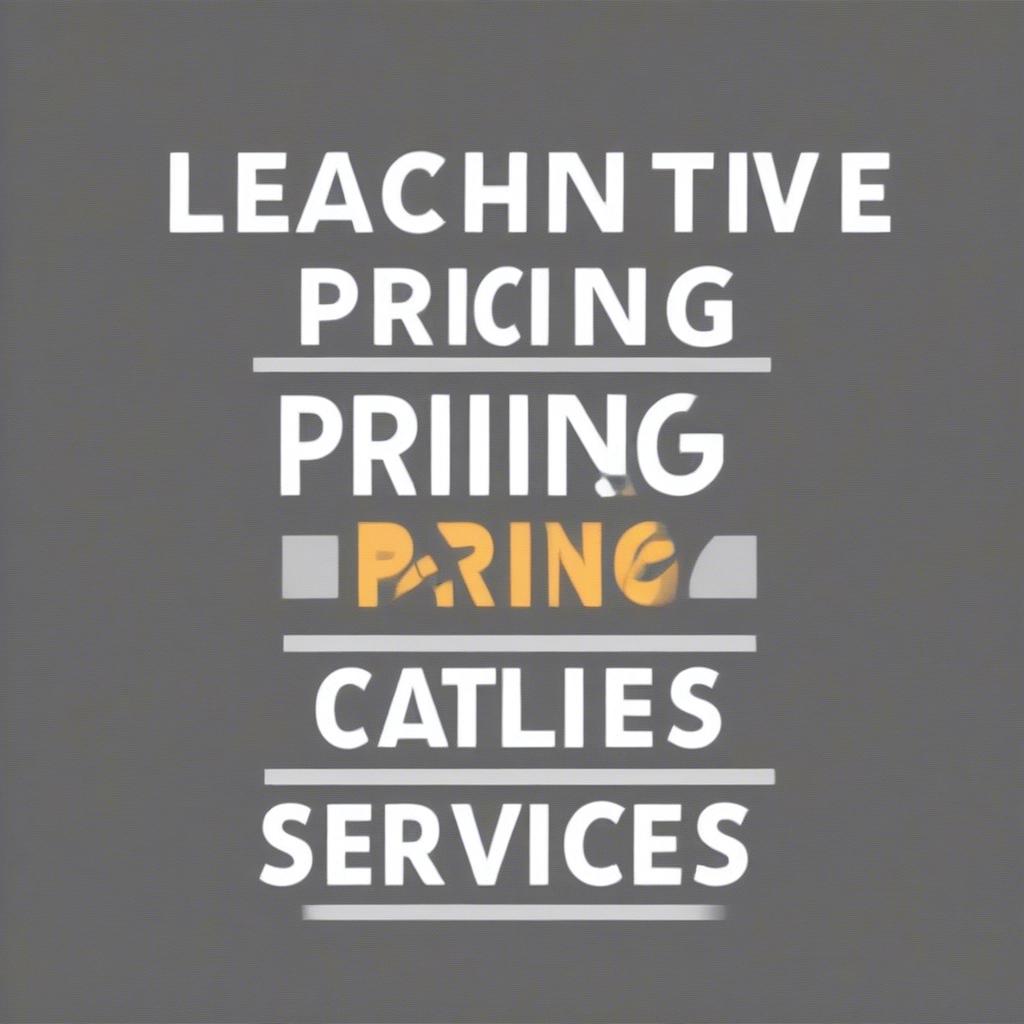
How to Set Competitive Pricing for Your Coaching Services
Figuring out how much to charge for your coaching services can feel like walking a tightrope. You want to be paid what you’re worth, but you also want to attract clients. It’s a delicate balance, and getting it right is crucial for the success of your coaching business. This article will be your comprehensive guide to mastering the art of coaching pricing strategies, ensuring you confidently set service pricing that’s both competitive and profitable.
Why is Pricing Your Coaching Services So Important?
Your coaching fees aren’t just numbers; they’re a statement about the value you bring. Here’s why getting your pricing right matters so much:
- Attracting the Right Clients: Pricing acts like a magnet. Too low, and you might attract clients who aren’t truly invested or see your work as less valuable. Too high, and you might scare away potential clients who could benefit from your services. Finding the sweet spot attracts those who genuinely value your expertise and are ready to commit.
- Reflecting Your Worth: You’ve invested time, energy, and resources into honing your coaching skills. Your pricing should reflect that investment and the results you deliver. Undervaluing yourself can lead to burnout and resentment.
- Ensuring Business Sustainability: You’re not just a coach, you’re also a business owner. Your coaching fees need to cover your expenses, including marketing, software, training, and of course, your time. Proper pricing allows your business to thrive, not just survive.
- Creating Perceived Value: In the coaching world, price often implies value. Higher prices (when justified) can position you as a premium coach, attracting clients seeking top-tier guidance.
- Building Confidence: Knowing you’re charging what you’re worth boosts your confidence, which translates to better coaching and client results.
Understanding Your Value Proposition: The Foundation of Your Pricing
Before we dive into specific pricing strategies, you need to understand your unique value proposition. What makes you different? Why should a client choose you over another coach?
Here are a few questions to ask yourself:
- What’s your niche? Are you a career coach, a health coach, a life coach, or something else entirely? The more specific your niche, the more specialized your expertise will be, which can command higher prices.
- What are your qualifications? Do you have certifications, years of experience, or specialized training? These credentials add credibility and justification for your coaching fees.
- What results do you deliver? Can you quantify the impact of your coaching? Do your clients achieve specific outcomes, such as landing a new job, improving their fitness, or increasing their confidence? If so, use the tangible results as a value driver.
- What is your personality and coaching style? Do you offer a specific approach to coaching that differentiates you from other coaches? Do you have a unique ability to build rapport?
- What extra value do you provide? Do you offer free resources, email support, community access, or other extras that enhance the client experience?
Identifying your unique value proposition is not just about justifying your prices, it’s about defining your brand and attracting the right clients.
Key Factors Affecting Your Coaching Service Pricing
Several factors influence how much you can realistically charge for your coaching services. Let’s explore the key components:
1. Your Experience and Expertise:
- Beginner: Starting out? Expect to charge lower fees while you gain experience and build your portfolio. Focus on the impact you’re having, and use client feedback to build more confidence in your pricing.
- Intermediate: With a few years of experience and positive results, you can increase your coaching fees to reflect the increased value you bring.
- Expert: Established coaches with significant experience, specialized training, and a strong track record can command premium rates.
2. The Coaching Niche:
- High-Demand Niches: Some niches, like executive coaching or business coaching, often command higher prices due to the potential return on investment for the client.
- Lower-Demand Niches: Niches that are highly saturated or less directly tied to quantifiable results might be more price-sensitive. It doesn’t mean that you need to devalue your coaching, rather it would require that you establish a good value proposition in your chosen niche and set an appropriate service pricing based on the perceived value.
3. Coaching Format and Structure:
- Individual Coaching: One-on-one sessions usually command higher fees due to the personalized attention and bespoke solutions you provide.
- Group Coaching: Group settings offer a more accessible price point, allowing you to work with multiple clients simultaneously.
- Online vs. In-Person: Online coaching is generally more cost-effective for the coach, thus sometimes reflected in the pricing, and may not be location-restricted. In-person coaching may have increased perceived value for those preferring a physical space.
- Coaching Packages: Offering various packages with different features and price points can make your services accessible to a broader range of clients, allowing them to choose something that fits their needs.
- Duration and Frequency: Consider if you’ll charge per hour, per session, or per package, and if you will offer session packages.
4. Your Operating Costs:
- Business Expenses: Don’t forget to factor in your operating costs, including marketing, software subscriptions, website hosting, insurance, and professional development.
- Time Investment: Consider the time you spend outside of coaching sessions, like preparation, administrative work, and follow-up.
5. Your Target Audience:
- Demographics: Consider the financial situations of your target clients. Are you targeting established professionals or new entrepreneurs?
- Client Expectations: Understand what your ideal client expects regarding pricing. They might be happy to pay premium if you are delivering premium results.
Coaching Pricing Strategies: Finding What Works for You
Now that you understand the factors influencing your coaching pricing, let’s explore some effective coaching pricing strategies:
1. Hourly Rate:
- How it works: You charge a set fee for each hour of coaching.
- Pros: Simple and easy to understand, especially for new coaches. It is also easy for the client to understand.
- Cons: May not be ideal for long-term engagements or clients who need more flexibility. It may also unintentionally reward a coach for slower sessions.
- Best for: Short-term coaching engagements, one-off consultations, or when you want to offer a simple transparent price structure.
- Example: Charging $150 per hour for a career coaching consultation.
2. Per Session Rate:
- How it works: You charge a set fee for each session, regardless of its length (within a certain reasonable time limit).
- Pros: Provides more flexibility than hourly rates, and may include some prep and follow-up work.
- Cons: Requires you to manage the time, ensuring that you get the desired result for your client.
- Best for: When you provide consistent sessions of defined length.
- Example: Charging $200 per session for a 90-minute health coaching session.
3. Package Pricing:
- How it works: You offer a bundle of sessions or services for a set price.
- Pros: Encourages clients to commit to a longer-term engagement, providing recurring revenue and better results. Offering different tiers of packages can also cater to different price points.
- Cons: Requires careful planning to ensure value in each package.
- Best for: Long-term coaching programs that provide a comprehensive experience.
- Example: Offering a three-month career coaching package with 6 sessions, email support, and resource materials for $1,500.
4. Value-Based Pricing:
- How it works: You price your services based on the value your clients receive from coaching.
- Pros: Allows you to charge higher prices by focusing on the impact and results you deliver.
- Cons: Can be challenging to implement, as you need to quantify and communicate your impact effectively.
- Best for: Coaches with a proven track record of delivering results and those who can clearly articulate the benefits of their services.
- Example: Charging $5,000 for a 6-month business coaching program that will help a client to grow their revenue by a minimum of 25%
5. Tiered Pricing:
- How it works: Offering different packages or service levels at varying price points.
- Pros: Appeals to a broader range of clients with different budgets and needs, and provides an upsell strategy to your clients.
- Cons: Requires you to create and manage multiple options.
- Best for: When you want to attract a diverse clientele and provide more options to your target audience.
- Example: Offering a basic package with 4 sessions, a premium package with 6 sessions and email support, and a VIP package with 8 sessions, unlimited support, and extra resources.
6. Retainer Pricing:
- How it works: Clients pay you a regular fee for ongoing access to your services.
- Pros: Provides a predictable income stream and fosters long-term client relationships.
- Cons: Requires significant trust and commitment from the client.
- Best for: Ongoing coaching support for high-achieving individuals or clients needing long-term accountability.
- Example: Charging a monthly retainer fee of $800 for ongoing support and guidance.
Step-by-Step Guide: Setting Your Coaching Fees
Here’s a practical, step-by-step guide to help you set your coaching fees:
- Research Your Market: Identify your competitors, and find out their coaching pricing. This will give you a benchmark to work with and you can either choose to compete or position yourself differently.
- Define Your Ideal Client: Understand their needs, expectations, and budget. This is a crucial step in setting appropriate service pricing.
- Calculate Your Operating Costs: Don’t forget the essential costs you’ll incur. Make sure that you’re pricing your services to cover expenses and generate profit.
- Assess Your Expertise: Honestly assess your experience, qualifications, and track record.
- Choose Your Pricing Strategy: Select a model (hourly, session-based, packages, etc.) that aligns with your preferences and goals.
- Test and Iterate: Don’t be afraid to test out different price points and monitor the results. You may need to experiment before finding your sweet spot.
- Communicate Your Value: Clearly articulate the benefits of your coaching to your clients and justify your coaching fees.
- Regularly Review and Adjust: Market conditions and your business will evolve. Be prepared to periodically review and adjust your coaching fees as needed.
Using Templates to Simplify Your Pricing Process
Creating pricing packages and contracts can be time-consuming. The use of templates can streamline this process. You can find various templates online; a great example is the Learn Business platform, which not only offers guidance on pricing strategies but provides a library of customizable templates tailored for coaches and other businesses. This will save you time, and help you create consistent brand representation.
Negotiating Your Coaching Fees
Negotiation is a part of business. While you should stand by your value, you can also have a few strategies for negotiating your coaching fees:
- Focus on Value, Not Cost: Reiterate the value you’ll be providing rather than just the price. Emphasize what the client stands to gain from working with you.
- Offer Flexibility: You can offer payment plans, smaller packages, or alternative solutions to fit their budget.
- Be Confident: Stand by your worth. A confident approach can often persuade a client to commit to your services.
- Know When to Walk Away: You don’t need to work with every client. If someone is trying to drastically undervalue your service, it may be better to walk away.
Common Mistakes to Avoid When Pricing Your Coaching Services
Here are a few common mistakes you might encounter when determining your coaching fees, and how to avoid them:
- Undervaluing Your Services: Don’t sell yourself short. Know your value and charge accordingly.
- Copying Your Competitors: While market research is important, don’t copy your competitors blindly. Focus on what makes you unique.
- Ignoring Your Operating Costs: Remember to factor in all business expenses when calculating your prices.
- Being Afraid to Raise Your Prices: Don’t shy away from raising prices as your experience and skills grow.
- Not Communicating Your Value: Clearly articulate the benefits and outcomes clients can expect from working with you.
How Learn Business Supports Your Coaching Journey
At Learn Business, we understand the challenges that coaches face when pricing their services. That’s why we provide a comprehensive suite of resources designed to empower you on your business journey. Our platform offers:
- Step-by-Step Guides: Practical guidance on all aspects of business, including marketing, client acquisition, and financial management.
- Customizable Templates: Easily create contracts, invoices, proposals, and other essential business documents. These templates are designed to save you time and make your business look professional.
- Expert Advice: Access valuable advice and insights from experienced business professionals.
- Community Support: Connect with other coaches, share experiences, and learn from each other.
- Workshops and Courses: Upgrade your skills and stay updated with the latest strategies for business growth.
We are dedicated to helping you streamline your business operations, allowing you to concentrate on what you do best – coaching. Check out the Learn Business platform and discover how it can support your success.
Conclusion: Mastering Your Coaching Pricing Strategy
Setting the right coaching pricing strategies is a crucial aspect of building a successful and sustainable coaching business. By understanding your value, considering your operating costs, and utilizing the right pricing strategies, you can confidently charge what you’re worth and attract the clients you deserve. Remember that your pricing is not set in stone, and you should be prepared to adjust as your business and experience evolve. You’ve got the expertise, so confidently set the appropriate service pricing to build a thriving practice!



Leave a Reply